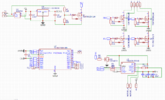Hi, I am designing my own locomotive DCC decoder, no need to know what that is. The major problem i am having now is that if i try to use the drv8251 the attiny1606 overheats and then burns out. Even when there is nothing connected to the output, i was just measuring the output voltage with a multimeter. Initially, everything was fine, but then, as i said, the mcu burnt out. The drv is using the reference voltage of the attiny, plus those resistors on the inputs should prevent possible overcurrent. Prior to assembling the whole PCB, I tested all the parts individually. First the voltage regulator, then separating the signal. And last i tested the drv. For the test, i used the same schematic for the drv as shown in the picture before, but instead of the attiny I was controlling it with arduino nano (vcc 5v). That seemed to work with no problem



